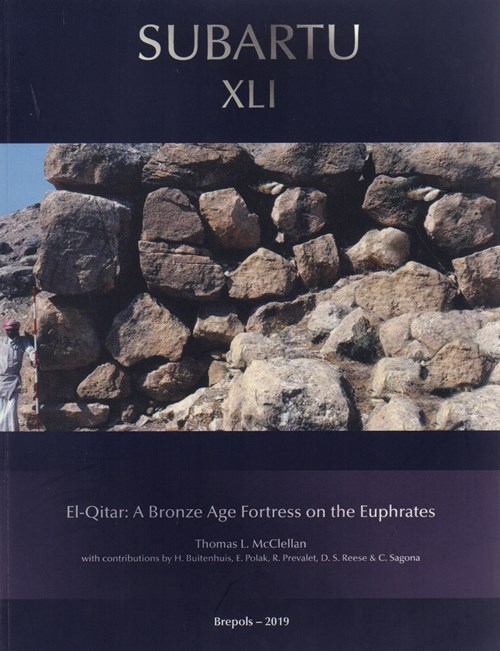El-Qitar : a Bronze Age fortress on the Euphrates / by Thomas Lynn McClellan ; with contributions by Hijlke Buitenhuis, Edward Polak, Romain Prevalet, David S. Reese, and Claudia Sagona.
Yer Numarası
B.II/0068
ISBN
9782503579955
Dil Kodu
İngilizce
Kütüphane
Türk Tarih Kurumu Kütüphanesi
Yayın Bilgisi
Turnhout, Belgium : Brepols, ©2019.
Fiziksel Niteleme
xxiii, 511 sayfa : resim, plan, tablo, çizim ; 28 cm.
Dizi
Subartu, 1780-3233 ; XLI
Bibliyografi, vb. Notu
Bibliyografya s. [501]-511.
İçindekiler Notu
List of illustrations -- Preface -- Introduction -- History of excavations -- Research aims -- Synopsis of work each season -- Some general notes -- Overview of the fortifications -- Topography : the mountain -- Geography and pairs of military forts -- Siting of the defences and settlements -- City Gates -- Towers -- Curtain walls -- Early and late defensive arrangements -- Magnetometer survey and possible dry moat -- Jebel Ahmar -- The West Gates -- Lower west gate -- The upper west gate, earlier and later ways into the settlement -- Stratification -- The rıver gate -- City gate and flanking towers -- Stratigraphy of the river gate area -- Town planning : settlement plans, sounding 11, and Tumuli -- The lower settlement (Area X) -- The upper settlement (Area Y) -- The upper settlement, North -- Tumuli on top of el-Qitar, Classical Period or Earlier? -- Buildings 16 and 17 -- Building 17 -- Building 16-West -- Building 16-East -- Building 12 -- Building 11 -- Introduction -- Unit 11A, Side-Room House -- Unit 11B, the Workshop -- Unit 11C, Central-Room House -- Building 10 - The Temple -- Architecture -- Stratigraphy and artefacts -- Building 14 - The orthostat building -- Rooms 42-43 -- Room 31 -- Room 112 -- Room 25 -- Building 15 -- Unit A -- Unit B -- Unit C -- Unit D -- Unit E -- Ceramic chronology -- Methodology -- The relative chronology of el-Qjtar groups -- Changes in the ceramic assemblages over time and pottery types distinctive to each period -- Pottery typology -- Pottery types and assemblages of different periods -- Other periods -- Discussion and issues -- Regional ceramic relative chronology of the Middle Euphrates (EUSER) -- Other sequences and absolute chronology -- Pottery in rooms and loci -- The objects -- Tablet -- Other seals and sealing -- Anthropomorphic figures -- Zoomorphic figures -- Metal objects and stone moulds -- Small stone objects -- Beads -- Shell / David S. Reese -- Ground-stone objects / Claudia Sagona -- The silver hoard / Romain Prevalet -- Catalogue of the silver hoard -- Conclusion about the hoard -- Works cited in chapter 14: The silver hoard -- A Hellenistic gold crescent earring of el-Qitar / Romain Prevalet -- Typology and structure -- Decoration -- Processes of Manufacture -- Processes of decoration -- Comparisons and historical conclusions -- Works cited in chapter 15: Hellenistic gold crescent-earring -- Magnetic Test Report / Edward Polak -- The instrument and field procedure -- Results in the upper settlement (Area Y) -- Conclusions -- Works cited in chapter 16: Magnetic test report -- The faunal remains from el-Qitar / Hijlke Buitenhuis -- Introduction -- The Species -- Conclusions -- Works cited in chapter 17: the faunal remains from el-Qitar -- Quantitative analysis of artefacts -- El-Qitar artefact distributions -- Comparisons of objects from Qitar, Bazi, and Munbaqa -- Taphonomic vs functional patterns -- Buildings : houses, workshops, and shops -- Temples -- Conclusions -- Early Bronze Age Tumuli -- Middle Bronze Age Fortress Qitar -- Laf e Bronze Age chronology of the Middle Euphrates -- Late Bronze Age Reoccupation of el-Qitar after a Gap -- Destruction of el-Qitar Period iv, EUSER 4 -- Minör Reoccupation of Qitar (and Munbaqa) in Qitar VI, EUSER 5 -- Appendices -- Appendix 1. Post-hole sizes in centimetres, diameter and depth, el-Qitar, Building 17, Room 56 -- Appendix 2. Pottery distribution in all recorded groups -- Appendix 3. Matrix of thirty-two groups, seriated using percentages of ninety-one types -- Appendix 4. Running list of objects in rooms -- Appendix 5. Measurements of the skeletal elements according to von den Driesch, 1976.
Özet, vb.
“Located along the River Euphrates, in modern-day Syria, el-Qitar was a mountain fortress of the Middle Bronze Age. Excavations, fully analysed in this volume for the first time, revealed extensive fortifications, with two city gates, multiple towers, a fosse, an earthen rampart, and casemate walls, in addition to a public building lined with orthostats of the Middle Bronze Age. After a short time, the site was abandoned and, following a gap of several centuries, re-settled in the Late Bronze Age. It was then that upper and lower settlements were established within the old fortifications, possibly in the wake of Hittite campaigns in Northern Syria that destroyed nearby towns. Detailed analyses of ceramics and objects explore the possibility that el-Qitar was re-occupied by local refugees. This volume traces the changing function of the site over time, arguing that el-Qitar might have been the site known as Dur Samsi-Addu during the Middle Bronze Age, and Til-Abnu of the Late Bronze Age. The latest construction episode belongs to the modern-day Tishreen Dam.” -- Arka kapak.
Konu
Emeği Geçenler
Buitenhuis, Hijlke, 1950- işbirliği.
Polak, Edward, işbirliği.
Prévalet, Romain, 1984- işbirliği.
Reese, David S., 1954- işbirliği.
Sagona, Claudia, 1956- işbirliği.
Polak, Edward, işbirliği.
Prévalet, Romain, 1984- işbirliği.
Reese, David S., 1954- işbirliği.
Sagona, Claudia, 1956- işbirliği.
Dizi Ek Girişi- Tek Biçim Başlık
Subartu ; 41.


